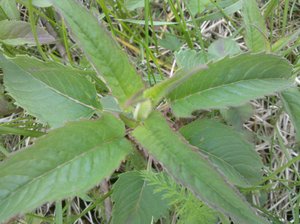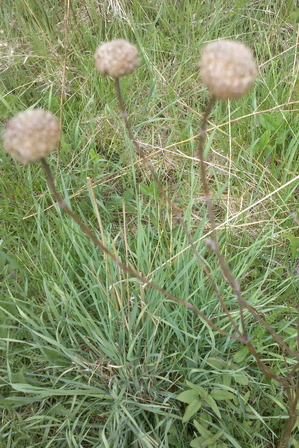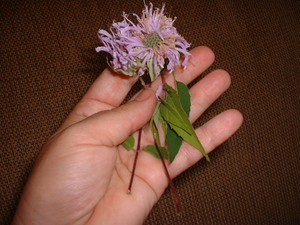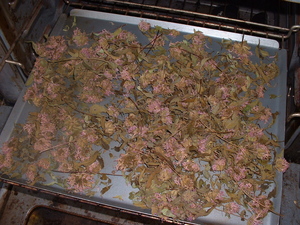Wildcrafting: Bee Balm - the smell is the best part

Bee Balm, also known as Bergamot, along the trail at Barton Dam
Linda Diane Feldt | Contributor
Most of the year Bee Balm blends in with the other simple green low growing plants with opposite leaves. I’ve overlooked it countless times, and I’ve mistaken other plants for it as well. But once you smell it, there is no mistaking it for another plant. Simply crush or rub the leaves and a wonderful scent of oregano with hints of mint and thyme is released. I smell the oregano predominantly, but that is a simplification of this rich, enticing, strong and lovely odor.
This native plant is found on the edges of woods, in fields, and likes bright sun light. It is in many Ann Arbor parks, in plain sight but can be hard to spot until it flowers.

Look for last year's dried flower stalks. Bee Balm is a perennial.
Linda Diane Feldt | Contributor
In July and August the plant is easy to spot, growing almost to your knee or higher with stringy looking flowers that are red or a light lavender. The flowers also have the wonderful aroma. And indeed the bees are attracted to it. Last summer I was clearly competing with a batch of bumblebees as I collected the wild flowers. We worked it out.
Bee Balm, also known as Bergamot, Latin name Monarda, includes over a dozen varieties. Monarda fistulosa is the wild local variety. I’ve been assured - erroneously it turns out - that this is the plant used in Earl Grey tea that gives it a special flavor. It is not. The Bergamot Oil added to Earl Grey is Citrus bergamia, an entirely different plant.

The flower of the local wild Bee Balm
Linda Diane Feldt | Contributor
Bee Balm is used as a tea, for both medicinal effects and for a pleasant flavor. The benefits include strong antiseptic value, as a stimulant for colds and sore throats (you can use it as a steam for sore throats as well) and gastric benefits for nausea and gas. It can be used externally for infections and when you have simple irritations of the skin that would be helped by a mild and gentle antiseptic.
I especially like to use it by the handful in spaghetti sauces, chili, on pizza and other places where I might otherwise have used basil or oregano. Is it my imagination that my chili is less gas producing when bee balm has been added? It seems to help.

Drying the Bee Balm, flowers and leaves, last August
Linda Diane Feldt | Contributor
I gather Bee Balm throughout the spring and summer, using the fresh leaves for the first few months. In August I like to gather enough to last the winter, flowers and all. Last year I dried a half gallon, and found that was much more than I needed even though I use a lot each time. Gathered fresh, it will last five to seven days in the refrigerator in a bag. To dry it either leave it out in a cool dry place for a few days until crumbly, or spread it on a cookie sheet in a slow (200 degree) oven. I bake it for two to three hours, and then often turn off the oven and leave it overnight. Store the dried herb in a glass jar with a tight lid in a cool dark place. Expect it to last about a year.
This is a fun plant to surprise your friends. I love to pick a few leaves, that have blended into the landscape, crush them and invite my companions to sniff. The smell is not something you would expect from such a simple nondescript plant. Almost everyone reacts with surprise and pleasure. Bee Balm is a nice addition to any walk through a woods or field.
Linda Diane Feldt is a Holistic Health Practitioner, teacher and writer. You can follow her on twitter, her Web site, or contact her at ldfeldt(at)holisticwisdom.org
Her cookbook Spinach and Beyond: Loving Life and Dark Green Leafy Vegetables is available at Crazy Wisdom Bookstore, and through Amazon.com.


Comments
SpiritGrove
Thu, Apr 29, 2010 : 8:12 p.m.
You're quite welcome. I'm glad you plan to write an article about the ethics of wildcrafting, great idea to help raise awareness about the subject! I've been wildcrafting since the 70s, and have seen numerous stands of great wild herbs and food plants utterly wiped out where things once looked plentiful, because folks harvested too many plants, and/or didn't let them re-seed. Not letting plants set seed because a stand is well established and superabundant, or because "You can hardly tell anyone has been there," is still problematic due to vagaries of Nature. Even with superabundance, there are natural disasters that can undo superabundance in a jiffy! Mother Nature doesn't need to leave footprints at a site or make it look like someone's been there, to be able to destroy a stand of plants in under a week. A single unpredictable natural disaster such as a plant disease specific to that kind of plant, a flood, a severe drought, a large critter such as a moose, elk or bear sleeping on the fragrant herbs, etc. can permanently wipe out even the most well established stands, if there are insufficient seeds left behind. Also, you might not be the only wildcrafter who finds a given site. It might look well established when you arrive, but there's still a good chance that others could discover the same site later than you in the same year, and then carelessly harvest most, or even nearly all, of the plant. A natural disaster such as berry disease, flood, drought, or overharvesting by other site visitors you never saw, or such factors combined, could indeed be why you saw no dewberries, where you used to find them. Just in case of disasters or unexpected, unseen overharvesting, it's always very important to let the plant set seed if at all possible. :)
Linda Diane Feldt
Thu, Apr 29, 2010 : 2:40 p.m.
@spiritgrove There can never be enough reminders of the interrelationship and responsibility associated with wildcrafting. Thank you for that. I'm more in tune with the bees than the hummingbirds, and they need this food as well late in the season. What I've observed around here, is that bee balm is so well established that even picking enough for a full year's use doesn't even begin to touch the abundance of the bee balm. You can hardly tell anyone has been there. I'm full of articles about the plants right now, (so many are up and want attention!) but will write again soon about the ethics of wildcrafting. Thank you for your addiittion on that important topic, as well as more uses.
SpiritGrove
Thu, Apr 29, 2010 : 2:27 p.m.
The medicinal and fragrance uses of this native plant were first discovered by Native American tribal people. Natives considerately taught settlers to make tea from the dried mature (post-seedset) flowerhead to treat fever and colds. Natives made a strong tea from fresh leaves of this to treat whooping cough, other infectious coughs like bronchitis, and also as gargle for sore throat, sore mouth or sore gums. Chewed leaves were placed on wounds as a poultice to stop bleeding and prevent infection. Chewed leaves also were used to treat insect stings. Boiled leaves were applied to pimples, cold sores or shingles, chickenpox and then smallpox once it was introduced, and boils. This was widely used by Natives and pioneers alike as a fragrance and fly-repellant for their bodies, horses, hair. Also used to repel moths from eating clothing and linens within people' homes. I'm part Native American, and use this plant for all the above traditional uses except for whooping cough, which thankfully is not much of a problem anymore. :)
SpiritGrove
Thu, Apr 29, 2010 : 2:06 p.m.
Personally, I think the hummingbirds attracted and fed by this plant are the best part. :) I place a very high value on wildlife preservation & attraction. As with the case of the Monarch and the milkweed, hummingbirds depend on this plant for food, so let's please take care to make sure the hummingbirds also can get fed! :) I use this plant for all the same uses you do, but I won't pick the flower heads of this, until after the little pink flowers have finished blooming & the flowerheads mature, turn brownish tan, and set seed. This is important so hummingbirds can feed, and also gives the plant a chance at seeding (botanical sexual reproduction). Sexual reproduction (seeding) is vital for the continuance of a wild plant patch. It ensures a wide gene pool in the population. A wide gene pool makes the group far more adaptable, ensuring better ability to survive diseases, insect pests, & environmental changes such as droughts, floods, temperature shifts, etc. I'm asking you and all others who collect this herb to kindly do the same as me. Please, harvest post-bloom, at seed-set stage. When mature flowertops are pale brownish-tan & are setting seed, the flavor is still perfect for use as a dried herb, far more flavorful than any storebought oregano. After collecting the mature brownish flowertops, I always shake the seeds out of the flowertops in suitable areas for new plants to grow, so seedlings can appear next year. :) These plants are not just humanity's, they belong to the gorgeous hummingbirds, and to our grandkids! Let's all cooperatively help the pretty little birdies to survive, and ensure the plants' adaptability and long term survival, by allowing seed to set. The hummingbirds, hummingbird appreciators, & our grandkids who will get to marvel at the sight of a hummingbird feeding from this plant, will be glad we all did! :)
swcornell
Mon, Oct 17, 2011 : 3:11 p.m.
I also appreciate the red flowered version of this plant for it's ability to attract hummingbirds. It does spread quickly though and can take over a garden if you don't control it every spring.
Sarah Rigg
Mon, Apr 26, 2010 : 8:29 a.m.
A friend just split his Bee Balm patch and gave me some, and I haven't been sure what to do with it, so this is really timely and helpful!